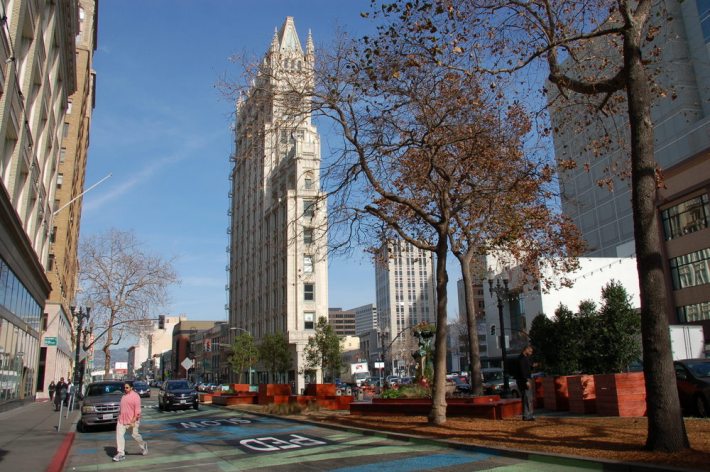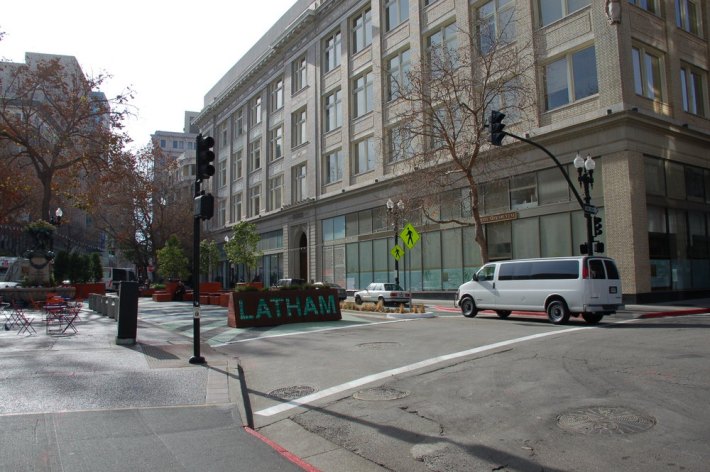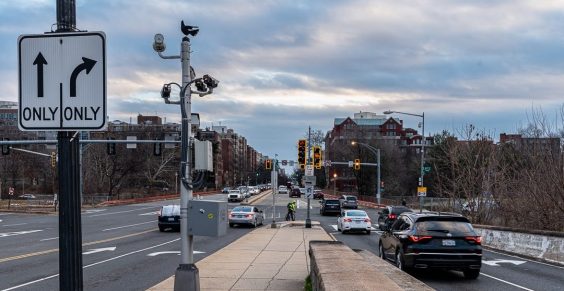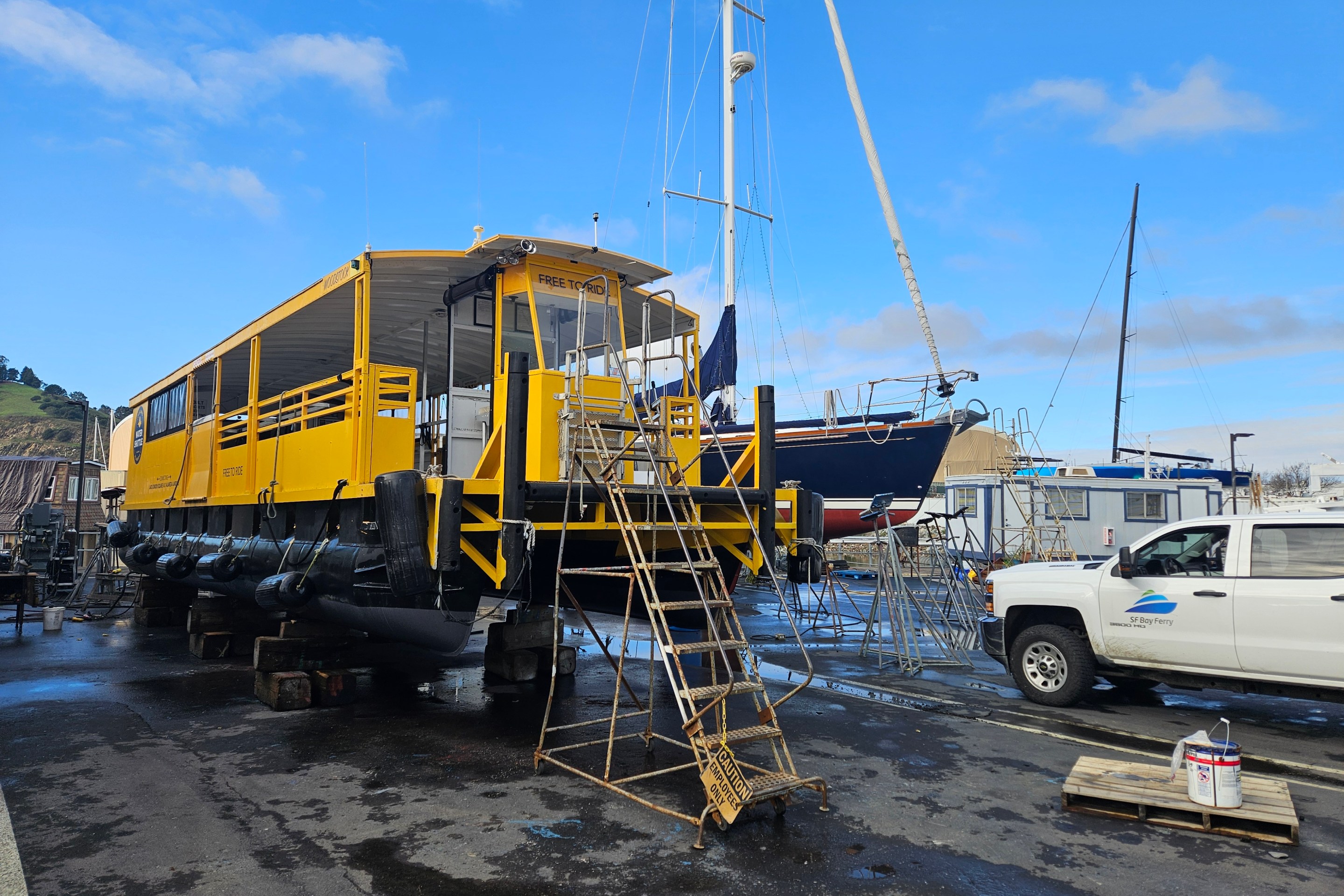After a trial public plaza at Latham Square was undercut by Oakland's Planning and Building Manager, the Oakland City Council voted last week to reinstate two-way car traffic on the small, southernmost block of Telegraph Avenue, caving to merchants and developers pushing for unfettered car access.
At their January 7 City Council meeting, Oakland council members considered different proposals for the layout of Telegraph at Broadway, a key gateway linking the bustling offices around City Center BART with the burgeoning Uptown dining and entertainment scene. Besides the critical role Latham Square Plaza will serve in the ongoing revitalization of the area, it also stands as a flashpoint in the broader movement to make Oakland more people-friendly. The council's vote to maintain lanes for car traffic was undeniably a setback for that movement.
Last summer, the city closed off vehicular lanes along the 1500 block of Telegraph and filled the space with seating, planters, and other pedestrian amenities as part of a six-month pilot project intended to gauge the feasibility of a permanent street closure. Complaints from nearby business owners, however, prompted the city to prematurely reopen one southbound lane of Telegraph after just six weeks.
The council’s final decision last week undermined the effort to create a people-friendly space in the heart of downtown Oakland. Although the proposal that city leaders adopted will still expand the plaza’s square footage from 2,500 (before the pilot project) to 9,500, livable streets advocates feel the restoration of two-way auto traffic will undercut the appeal of the space and create a safety hazard for people who use it. Altogether, two of the three original traffic lanes will be reinstated.
While some of the 34 people who spoke at the City Council meeting pushed for a totally car-free option (11,000 square feet of pedestrian space), many others were willing to meet halfway and endorse a design that would retain one southbound lane of Telegraph for traffic.
Jonathan Bair, board president of Walk Oakland Bike Oakland, told council members that his organization preferred a total pedestrianization, but in the spirit of compromise encouraged officials opt for the design with one traffic lane. He spoke against the two-way traffic proposal, asserting, “Faster and more cars and big rigs running alongside what amounts to a large median is not a good use of our scarce public resources.” Several subsequent speakers echoed WOBO’s position, and though Council Member Dan Kalb later submitted the one-lane idea within an alternate proposal, the council quickly voted it down.
Most of the 11 people who testified in favor of the two-way traffic proposal cited car access to retail as their primary concern. These speakers — business owners along Telegraph and residents of the Cathedral Building that borders the plaza on the north — claimed the plaza trial had resulted in a drop in business, and argued that disrupting vehicle flow would discourage people from visiting downtown.
“Ever since the pilot project was started,” said Travis Kuhl, “my business has fell off immensely. I think today three people walked in my door.” The proprietor of Kuhl Frames + Art added that two shoe stores on the next block north had just gone out of business, “so obviously this project didn’t work."
One large and especially well-heeled entity managed to cast a shadow over the proceedings in absentia.
A developer -- identified by the Oakland Tribune as Strategic Urban Development Alliance -- is looking to purchase the underutilized Sears building cradled by Telegraph, 20th Street, and Broadway, with the intent to turn it into a retail and office center. Lynette Gibson McElhaney, who represents the downtown area as council member for District 3, called the prospect a "game-changer" and mentioned she had received comments from the developer indicating "the desire there to see two-way traffic."
After several speakers expressed frustration that this information held too much sway over the council’s deliberations -- and after McElhaney had formally moved for the council to adopt the two-way proposal — she clarified the developer’s position. "It is not that the developer has said they would not bring the investment, but the question is, whether or not they can continue to pull together the economic investment from the investment community that they need, and they have suggested that this, having one-way traffic, would be a deterrent to the capital drive that is underway," she said.
In the end, these vague financial concerns about car access appeared to dictate the council’s decision, demonstrating how skittish Oakland has felt over the rapid and surprising resurgence of its downtown, which just five years ago felt more like a ghost town in certain pockets. As city leaders attempt to keep the turnaround going, residents will want to monitor the process, urging officials to embrace innovative and inclusive planning. Clinging timidly to the cars-first status quo is a bad strategy to keep the momentum going.
The next opportunity to discuss Latham Square Plaza will be on Thursday, January 30 from 6 to 8 p.m. in the office of AIA East Bay at 1405 Clay Street, where city staff will host a public meeting to solicit input about lighting, landscaping, furniture, fixtures, seating, paving treatments, and more.







